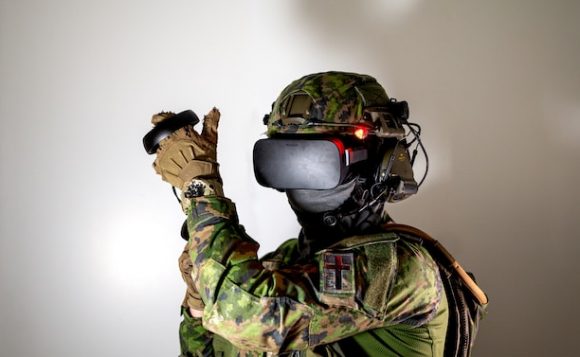
Despite the fact virtual reality became a widely discussed topic only a few years ago, the first VR programs were developed back in the 60s of the previous century. During this period, the American army began implementing virtual reality as a tool to train soldiers.
Considering the fact that today virtual reality technology is developing rapidly, VR was implemented into other fields of military training, particularly in the armies of the USA, United Kingdom, and Ukraine, during the war with Russia.
In this article, we will highlight the fields of implementing virtual reality in the army and what advantages VR gives to the military field.
How Virtual Reality is Changing Military Training for Better
Military VR training is applied for improving soldiers’ combat and tactical skills and accelerating wielding equipment process.
The US Forces apply virtual reality to prepare infantry for combat operations. Just like, for example, in this video, where American soldiers train in a fully virtual environment, using training rifles.
Speaking about Ukraine, VR is applied for training fighters who operate anti-tank and anti-aircraft weapons like NLAW and different types of MANPADS.
VR Military Equipment Training For Modern Soldiers
Virtual reality military training is also applied not just for infantry, but those who operate air defense systems. Recently, the Ukrainian Air Defence Forces Military Unit “Zahid” received VR headsets to improve shooting down enemy missiles, aircraft, and drones every day.
“These simulators allow us to train personnel and maintain their knowledge level in practice, so they could perform their defense tasks as efficiently as possible. Before entering on duty, military personnel who guard facilities, are also pass the training, because realism is its main advantage. Militaries see a hostile target and destroy it in virtual reality”, said Denys Levkovych, The Commander of The Staff.
Saving Lives with VR: How Tactical Medical Training is Being Transformed
Virtual reality training for tactical medics allows them to acquire practical skills that will be needed on a battlefield faster. Also, VR training helps them to accelerate muscle memory development, so tactical medics could realize how to act in a critical situation instantly.
Birmingham University in the UK developed mixed reality training for tactical medics to help wounded fighters. Especially for the training, a hyperrealistic mannequin was designed and transferred into virtual reality. A VR headset user both sees a mannequin’s digital twin and is able to touch a physical one in the real world.
“Essentially how this works”, said doctor Robert Guest, Lead Simulation Developer, “is we are tracking, using infrared cameras on person’s head, as well as their hands, using points on their gloves and a head tracker on a head-mounted display. And this allows us to align their real-world actions with virtual actions. So, we can see them move the head and the hands and they will roughly align to the virtual world. So, we both got a virtual body here and we’ve also got a real simulated body in the real world.”
VR Flight Simulators: Future of Military Pilot Training
VR simulations for pilots are considered to be one of the earliest use cases of virtual reality. In VR, pilots are in the cockpit mockup or at the computer table and see a realistic simulation of the sky. VR training allows pilots to pass through different tasks, improve their skills, and master new aircraft models with no risk to life and health.
Ukrainian pilots, who protect the sky, also train in virtual reality. Back in May last year, Oculus founder and current CEO of Anduril Palmer Luckey, with the support of the Ukrainian Government, secretly implemented a VR training program for Ukrainian pilots to improve their skills in VR headset Quest 2. The training is based on the American jet plane А-10 Thunderbolt II (aka The Warthog).
A virtual training program for Ukrainian pilots was developed with the assistance of active and retired US pilots, along with Ukrainian infantry officer Alexander Gorgan.
VR Therapy: Treatment for Soldiers with PTSD
Among war veterans, post-traumatic stress disorder is one of the most widespread mental disorders. According to the US Department of Veterans Affairs, 10% of men and 19% of women suffer from PTSD.
To cure post-traumatic stress disorder symptoms, some specialists apply exposure therapy. It’s the therapy, where a doctor puts a patient with PTSD in a virtual environment, that recreates a war environment. During the therapy, a patient faces traumatic factors, learns how to deal with them, and rethinks traumatic events in a safe and fully controlled environment.
Cardiff University organized a two-year-long research, known as 3DMR, featuring former militaries who went through VR therapy. As research proved, two-thirds of those who took part in the therapy felt an improvement in their mental well-being by 37%.
“We are helping individuals to overcome the avoidance, by walking towards the picture on a treadmill it’s very difficult to avoid and we know that we have to get rid of the avoidance to help an individual to process their traumatic memory,” said professor Jon Bisson from Cardiff university.
We partially highlighted the topic of virtual reality as a tool to improve patient’s mental health, including the ones with PTSD. We wrote about the ways VR is used for the psychological rehabilitation of patients here.
Main Benefits of Virtual Reality in Army
Virtual reality is widely applied in the military field due to its numerous advantages, such as
- Safe training that recreates the battlefield as realistic as possible;
- Wide range of locations — considering the fact that military training is held in virtual reality, it gives army unlimited possibilities to design any suitable training location;
- Virtual training for soldiers are available at any time at any place, even in the battlefield itself;
- Virtual simulations for military officers can be adapted according to the abilities and qualification level of those who train;
- A possibility to record data in virtual reality — this function allows VR headsets users to analyze their mistakes and improve their combat and tactical skills.
Main Challenges of Implementing VR For Army
During the creation of VR program for military officers, you should consider these nuances, including
- Safety of the data. Specialists are concerned that data in virtual reality can be leaked. Especially for the army officers, who usually work with top secret projects, organize secret special operations, or plan the next move in a war, so their enemy wouldn’t know that.
- Motion sickness. Due to the specifics of VR equipment, fighters can’t train in virtual reality all the time. Excessive use of headsets can cause some symptoms, e.g., sickness, vertigo, etc.
For more than a year, Ukraine has been at war with the Russian Federation. To protect our land from the enemy, our warriors use different kinds of weapons that are efficient in the fight. Besides the real arms, Ukrainian soldiers apply virtual reality, which is proven to be a reliable tool for the improvement of skills of infantry, pilots, tactical medics, etc. In this article, we also highlighted the experience of the successful use of VR by armies of different countries like the USA and the UK.



